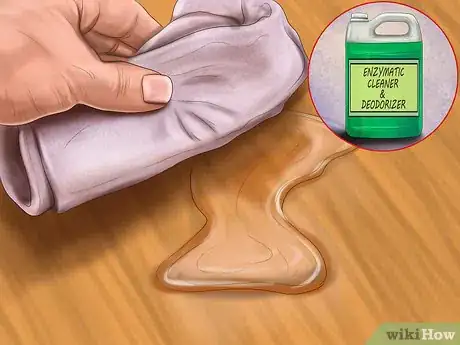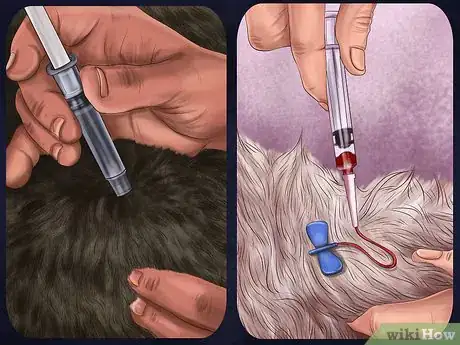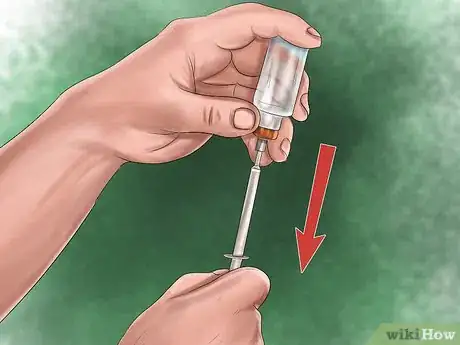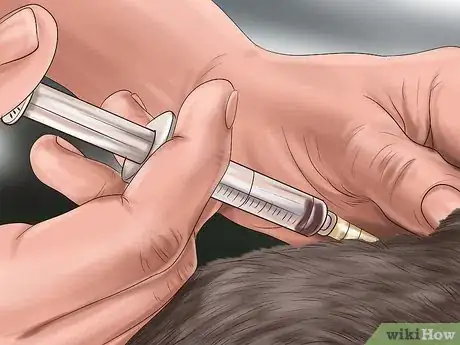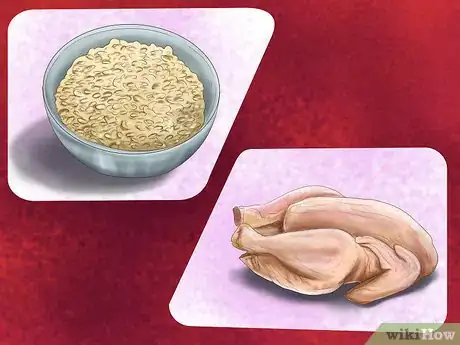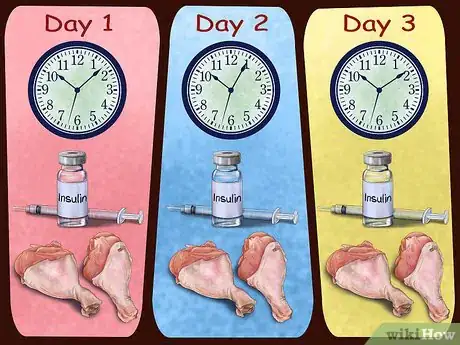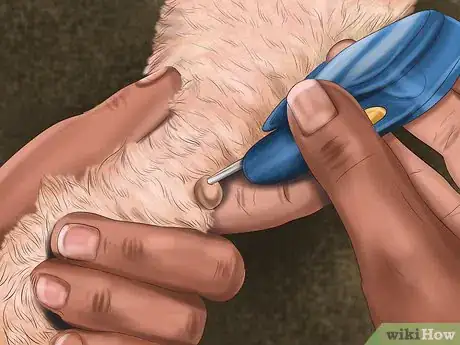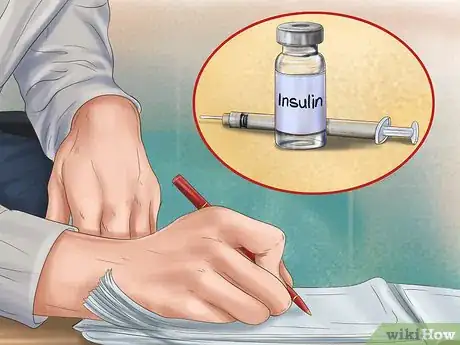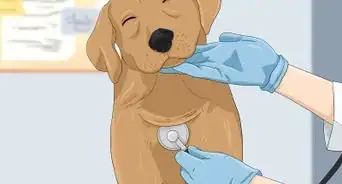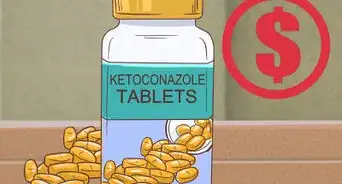This article was co-authored by Pippa Elliott, MRCVS. Dr. Elliott, BVMS, MRCVS is a veterinarian with over 30 years of experience in veterinary surgery and companion animal practice. She graduated from the University of Glasgow in 1987 with a degree in veterinary medicine and surgery. She has worked at the same animal clinic in her hometown for over 20 years.
There are 13 references cited in this article, which can be found at the bottom of the page.
This article has been viewed 21,802 times.
Diabetes is a common disease in dogs. It occurs when blood glucose levels are too high, either because the pancreas is not producing enough insulin (Type 1 diabetes), or because cells become resistant to insulin (Type 2 diabetes).[1] Miniature schnauzers have a high risk of developing diabetes.[2] If you have a miniature schnauzer, you should learn how to recognize and treat diabetes. Although diabetes has no cure, effective treatment can allow your miniature schnauzer to live a long and happy life.
Steps
Recognizing Diabetes
-
1Monitor your miniature schnauzer’s eating and drinking habits. Diabetes may cause your miniature schnauzer to become hungry frequently and drink more water. The hunger results from glucose in the blood not making it to the brain—without much glucose, the brain will send out ‘hunger’ signals, even if your dog is eating. Diabetes makes a dog thirsty because he is urinating more.[3]
- Your miniature schnauzer may start eating more to satisfy his hunger.[4]
- Don’t be surprised if you’re refilling your dog’s water bowl more frequently.
-
2Observe how frequently your miniature schnauzer urinates. With increased water intake, your miniature schnauzer will urinate more frequently. This may lead to more accidents in your home.[5] If your miniature schnauzer has an accident, clean it up with an enzymatic cleaner that will remove the urine's scent.
- Do not punish your miniature schnauzer if he has an accident.[6] Remember that it is the diabetes causing him to urinate more, not bad behavior.
Advertisement -
3Look for changes in your miniature schnauzer’s energy levels. Diabetes may cause your miniature schnauzer to feel tired. This is because the glucose in his blood isn’t reaching his muscles, where glucose would be converted to energy. Without much energy, he will feel more tired than usual.[7]
-
4Examine your miniature schnauzer’s body and coat condition. Sudden weight changes can occur with diabetes—either weight gain or weight loss. Diabetes can also lead to a poor coat condition (e.g., dry, brittle fur).[8] If your miniature schnauzer has gained weight, it may be due to his increased appetite.[9]
-
5
-
6Take your miniature schnauzer to your veterinarian. If you think your miniature schnauzer has diabetes, take him to your veterinarian. Your veterinarian will examine your miniature schnauzer and run different diagnostic tests (e.g., blood work, analysis of the urine) to diagnose diabetes. Indications of diabetes on the blood work will include high levels of blood glucose and some liver enzymes.[12]
- Glucose in the urine indicates diabetes.[13] Any level of glucose in the urine is abnormal, since glucose is not supposed to be in the urine at all.
- If your veterinarian identifies other health conditions during the exam, your miniature schnauzer would need to be treated for those along with his diabetes treatment.
Treating Diabetes with Insulin
-
1Determine the correct insulin dose. Several types of insulin are available to treat diabetes in dogs, with NPH being the most common.[14] Diabetic dogs respond to insulin differently, so insulin dosage must be determined individually.[15] To determine the insulin dosage for your miniature schnauzer, your veterinarian will hospitalize him for a day. During this time, your veterinarian will give him a certain insulin dosage, feed him normally, and take blood samples every 2 hours to measure blood glucose levels.[16]
- Your veterinarian will use these blood glucose levels to create a blood glucose curve. The curve will allow your veterinarian to determine which insulin dosage will be most effective at maintaining your dog’s normal blood glucose levels (between 90 and 180 to 216 mg/dl).
- Your veterinarian may need to perform several blood glucose tests to determine the ideal insulin dosage.
-
2Prepare the insulin. To give your miniature schnauzer his insulin, you will first need to prepare it. Evenly disperse the insulin within the bottle by rolling the bottle gently in your hands. Do not shake the bottle, as insulin is a delicate molecule that is easily damaged.
- Keep the insulin stored in your refrigerator, where it will not freeze.[17]
-
3Draw up the insulin into the syringe. Remove the plastic cap from the needle of the insulin syringe. Make sure the syringe’s plunger is at ‘0.’[18] With the insulin bottle in one hand, insert the needle into the bottle, without bending the needle. Turn the bottle upside down so the top of the bottle is facing down.
- With your hand holding the syringe, use your thumb and index finger to pull the plunger back and draw up the prescribed amount of insulin. If you see air bubbles, you can either flick them out with your fingers or push the insulin back into the bottle and try again.[19]
-
4Insert the needle under your miniature schnauzer’s skin. Insulin is injected just underneath the skin in the subcutaneous space. With your non-dominant hand, use your thumb and index finger to lift up a section of skin along your miniature schnauzer’s back, creating a ‘tent’ of skin. Quickly insert the needle just under the skin and into the tent at a 45-degree angle, making sure the needle doesn’t poke out the other side.[20]
- You will feel resistance if you put the needle in the skin instead of under it.[21]
- It may take a few tries before your miniature schnauzer adjusts to what you are doing. Be patient with him.
-
5Inject the insulin. Push the plunger with your thumb to inject the insulin, then withdraw the needle. Pet your miniature schnauzer and give him verbal praise for behaving well during the injection. Since you may not be able to throw the used needles in the trash, ask your veterinarian how to dispose of them.[22]
Implementing Other Diabetes Treatment Strategies
-
1Feed your miniature schnauzer a healthy diet. A healthy diet is essential to effective diabetes treatment in dogs. A healthy commercial dog food will have a high quality protein (e.g., chicken, beef), complex carbohydrates (e.g., whole grains), and a high amount of fiber. It will also be low in fat. A healthy diet will keep your miniature schnauzer’s blood glucose levels steady.[23]
- Do not feed your miniature schnauzer soft or moist foods; these can cause rapid increases in blood glucose levels.[24]
- Treats may not be a good idea for your miniature schnauzer if he has diabetes. Talk with your veterinarian about including treats in your dog’s diet.[25]
- Your veterinarian can give you recommendations on diabetic diets for dogs.[26]
-
2Maintain a strict feeding regimen for your miniature schnauzer. Not only does your miniature need to eat a healthy diet, but he needs to eat it consistently. Each day, before receiving his insulin, he should have the same food, in the same amount, and at the same time.[27] By keeping a strict feeding regimen, your miniature schnauzer’s blood glucose levels will remain steady throughout the day.
- Small, frequent meals throughout the day are ideal.[28]
-
3Manage your miniature schnauzer’s weight. Obese dogs have an increased risk of diabetes. Excess weight can also make diabetes treatment more challenging. If your miniature schnauzer is overweight or obese, he will need to lose weight as part of his diabetes treatment. Weight loss should be gradual.[29]
- Work with your veterinarian to develop a weight loss plan for your miniature schnauzer. It will include ways to increase his activity and reduce his caloric intake.
-
4Exercise your miniature schnauzer each day. Daily exercise is an important aspect of diabetes treatment. Exercise can lower blood glucose levels by helping muscles absorb insulin and convert glucose to energy. Do not have your miniature schnauzer exercise too intensely—his muscles may use up too much glucose, causing him to have too little glucose in his blood.[30]
- A few walks during the day could be enough exercise for your miniature schnauzer. Talk with your veterinarian about a good exercise plan for your dog.
Monitoring Your Miniature Schnauzer
-
1Make daily observations of your miniature schnauzer’s habits. Keeping records of your miniature schnauzer’s progress during diabetes treatment is very helpful. For example, write down daily observations of how much he’s eating, drinking, and urinating.[31] The insulin should help him maintain a normal appetite and not drink water or urinate excessively.
- Keeping a written record of the eating habits can also help you see if you are maintaining the strict feeding regimen.
-
2Measure your miniature schnauzer’s glucose levels. You can measure glucose levels at home by using a glucose monitor or urine dipsticks. To use the glucose monitor, use a small lancet (available through your veterinarian or at a local pharmacy) to puncture your dog’s skin and get a blood sample. The monitor will suck in this blood sample and calculate the blood glucose level. The urine dipstick would provide an estimated level of glucose in the urine.[32]
- The glucose level will indicate the insulin’s effectiveness.
- Glucose monitors are available at your local pharmacy.
- The urine dipstick is not as accurate as the glucose monitor.[33]
- Talk with your veterinarian to decide which measuring method will work best for you and your miniature schnauzer.
- Write down the glucose levels each time you take a measurement.
-
3Record the amount of insulin you give your miniature schnauzer. After each insulin injection, write down how much you gave and when.[34] If your miniature schnauzer reaches a point where he is not responding well to the insulin dosage, take him to your veterinarian for another blood glucose test. Do not adjust the dosage on your own! Talk to your veterinarian before making any dosage adjustments.[35]
-
4Watch for signs of hypoglycemia. During diabetes treatment, your miniature schnauzer’s blood glucose levels could become too low (‘hypoglycemia’). Causes of hypoglycemia include too much insulin, dietary changes (e.g., not eating the entire meal, eating at different time), and intense exercise. Hypoglycemia can be serious and fatal, so recognizing its clinical signs is very important.[36]
- Clinical signs of hypoglycemia include weakness, muscle tremors, confusion and unsteadiness.
- If your miniature schnauzer is showing any signs of hypoglycemia, take him to your veterinarian right away.
Expert Q&A
-
QuestionAre miniature schnauzers prone to diabetes?
 Pippa Elliott, MRCVSDr. Elliott, BVMS, MRCVS is a veterinarian with over 30 years of experience in veterinary surgery and companion animal practice. She graduated from the University of Glasgow in 1987 with a degree in veterinary medicine and surgery. She has worked at the same animal clinic in her hometown for over 20 years.
Pippa Elliott, MRCVSDr. Elliott, BVMS, MRCVS is a veterinarian with over 30 years of experience in veterinary surgery and companion animal practice. She graduated from the University of Glasgow in 1987 with a degree in veterinary medicine and surgery. She has worked at the same animal clinic in her hometown for over 20 years.
Veterinarian Sadly, yes, they do seem prone to diabetes. With this in mind, it's essential to watch their waistline and keep the dog trim. This is because obesity is another risk factor, but an avoidable one.
Sadly, yes, they do seem prone to diabetes. With this in mind, it's essential to watch their waistline and keep the dog trim. This is because obesity is another risk factor, but an avoidable one. -
QuestionCan diabetes in dogs be cured?
 Pippa Elliott, MRCVSDr. Elliott, BVMS, MRCVS is a veterinarian with over 30 years of experience in veterinary surgery and companion animal practice. She graduated from the University of Glasgow in 1987 with a degree in veterinary medicine and surgery. She has worked at the same animal clinic in her hometown for over 20 years.
Pippa Elliott, MRCVSDr. Elliott, BVMS, MRCVS is a veterinarian with over 30 years of experience in veterinary surgery and companion animal practice. She graduated from the University of Glasgow in 1987 with a degree in veterinary medicine and surgery. She has worked at the same animal clinic in her hometown for over 20 years.
Veterinarian The vast majority of diabetic dogs need insulin therapy to keep them well, and no, diabetes isn't curable. There is some evidence in cats that they can go into remission when a dedicated owner gives an appropriate diet. However, this is less common in dogs than cats.
The vast majority of diabetic dogs need insulin therapy to keep them well, and no, diabetes isn't curable. There is some evidence in cats that they can go into remission when a dedicated owner gives an appropriate diet. However, this is less common in dogs than cats. -
QuestionHow can I treat my diabetic dog without insulin?
 Pippa Elliott, MRCVSDr. Elliott, BVMS, MRCVS is a veterinarian with over 30 years of experience in veterinary surgery and companion animal practice. She graduated from the University of Glasgow in 1987 with a degree in veterinary medicine and surgery. She has worked at the same animal clinic in her hometown for over 20 years.
Pippa Elliott, MRCVSDr. Elliott, BVMS, MRCVS is a veterinarian with over 30 years of experience in veterinary surgery and companion animal practice. She graduated from the University of Glasgow in 1987 with a degree in veterinary medicine and surgery. She has worked at the same animal clinic in her hometown for over 20 years.
Veterinarian Sadly, without insulin, diabetic dogs do poorly. Diet is a big factor, and feeding a good quality diet that avoids spikes in blood glucose will help slow deterioration. But this is only a small part of blood sugar control and, to stay well, insulin therapy is essential.
Sadly, without insulin, diabetic dogs do poorly. Diet is a big factor, and feeding a good quality diet that avoids spikes in blood glucose will help slow deterioration. But this is only a small part of blood sugar control and, to stay well, insulin therapy is essential.
Warnings
- Dogs with poorly controlled diabetes can develop a serious condition called diabetic ketoacidosis. This condition requires immediate and intense veterinary care.[42]⧼thumbs_response⧽
- Several diseases, such as Cushing’s disease and hypothyroidism, can make diabetes difficult to manage.[43]⧼thumbs_response⧽
References
- ↑ http://www.petmd.com/dog/conditions/endocrine/c_dg_diabetes_mellitus_wo_complication?page=show
- ↑ http://www.peteducation.com/article.cfm?c=2+2097&aid=3587
- ↑ http://www.petmd.com/dog/conditions/endocrine/c_dg_diabetes_mellitus_wo_complication?page=show
- ↑ http://www.peteducation.com/article.cfm?c=2+2097&aid=3587
- ↑ http://www.schnauzers-rule.com/diabetes.html
- ↑ http://www.humanesociety.org/animals/dogs/tips/housetraining_puppies.html
- ↑ http://www.petmd.com/dog/conditions/endocrine/c_dg_diabetes_mellitus_wo_complication?page=show
- ↑ http://www.schnauzers-rule.com/diabetes.html
- ↑ http://www.petmd.com/dog/conditions/endocrine/c_dg_diabetes_mellitus_wo_complication?page=show
- ↑ http://www.merckvetmanual.com/mvm/endocrine_system/the_pancreas/diabetes_mellitus.html
- ↑ https://animaleyecare.net/informational/cataracts-blindness-and-diabetic-dogs
- ↑ http://www.vcahospitals.com/main/pet-health-information/article/animal-health/diabetes-in-dogs-testing-and-monitoring/1083
- ↑ http://www.merckvetmanual.com/mvm/endocrine_system/the_pancreas/diabetes_mellitus.html
- ↑ http://www.peteducation.com/article.cfm?c=2+2097&aid=3587
- ↑ http://www.petdiabetesmonth.com/dog_managing_insulin.asp
- ↑ http://www.vcahospitals.com/main/pet-health-information/article/animal-health/diabetes-in-dogs-testing-and-monitoring/1083
- ↑ http://www.2ndchance.info/diabetesdog.htm
- ↑ http://www.vcahospitals.com/main/pet-health-information/article/animal-health/diabetes-mellitus-insulin-treatment-in-dogs/746
- ↑ http://www.2ndchance.info/diabetesdog.htm
- ↑ http://www.vcahospitals.com/main/pet-health-information/article/animal-health/diabetes-mellitus-insulin-treatment-in-dogs/746
- ↑ http://www.2ndchance.info/diabetesdog.htm
- ↑ http://www.vcahospitals.com/main/pet-health-information/article/animal-health/diabetes-mellitus-insulin-treatment-in-dogs/746
- ↑ http://www.petdiabetesmonth.com/dog_managing_diet.asp
- ↑ http://www.petmd.com/dog/conditions/endocrine/c_dg_diabetes_mellitus_wo_complication?page=show
- ↑ http://www.peteducation.com/article.cfm?c=2+2097&aid=3587
- ↑ https://www.vetinfo.com/canine-diabetic.html
- ↑ http://www.peteducation.com/article.cfm?c=2+2097&aid=3587
- ↑ http://www.schnauzers-rule.com/diabetes.html
- ↑ http://www.petmd.com/dog/conditions/endocrine/c_dg_diabetes_mellitus_wo_complication?page=show
- ↑ https://www.vetinfo.com/canine-diabetic.html
- ↑ http://www.petmd.com/dog/conditions/endocrine/c_dg_diabetes_mellitus_wo_complication?page=show
- ↑ http://www.peteducation.com/article.cfm?c=2+2097&aid=3587
- ↑ http://www.2ndchance.info/diabetesdog.htm
- ↑ http://www.petmd.com/dog/conditions/endocrine/c_dg_diabetes_mellitus_wo_complication?page=show
- ↑ http://www.2ndchance.info/diabetesdog.htm
- ↑ http://www.peteducation.com/article.cfm?c=2+2097&aid=3587
- ↑ www.vetthink.net/upload/Miniature%20Schnauzer%20Electronic%20Handout_PDF.pdf
- ↑ http://www.petdiabetesmonth.com/dog_managing_insulin.asp
- ↑ http://www.peteducation.com/article.cfm?c=2+2097&aid=3587
- ↑ http://www.petmd.com/dog/conditions/endocrine/c_dg_diabetes_mellitus_wo_complication?page=show
- ↑ http://www.peteducation.com/article.cfm?c=2+2097&aid=3587
- ↑ http://www.peteducation.com/article.cfm?c=2+2097&aid=3587
- ↑ http://www.peteducation.com/article.cfm?c=2+2097&aid=3587
About This Article
If your miniature schnauzer has been diagnosed with diabetes, have your veterinarian determine the correct insulin dose needed to treat it. To give your dog its insulin, prepare it by rolling the bottle gently in your hands to disperse the insulin evenly. Then, use the syringe to draw up the correct dose of insulin from the bottle. To inject the insulin, use your non-dominant hand to lift up a bit of your dog’s skin into a tent. Then, use your dominant hand to insert the needle into the tent of skin at a 45-degree angle and press the plunger down. When you’re done, pet your dog and praise him for behaving well during the injection. For more information from our Veterinary co-author, like how to measure your miniature schnauzer’s glucose levels, keep reading!

